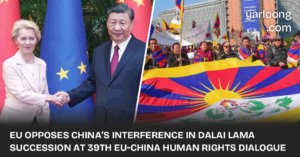Summary: In Northern Tibet, children are using traditional stone-throwing ropes, known as “urduo,” to protest against what they and Uyghurs term “genocide tourism.” These demonstrations aim to reveal the harsh realities masked by state-controlled tours, which showcase a deceptive peace and cultural harmony under strict surveillance.
A Unique Form of Protest
In the stark landscapes of Northern Tibet, particularly around the prefecture-level city of Nagqu, children have taken a stand against the influx of tourists who are shown only a sanitized version of Tibetan life under Chinese rule.
Using “urduo,” ropes traditionally made from yak or goat hair used by herdsmen for managing livestock and protecting against wild animals, these children engage in a symbolic protest. As trains filled with tourists pass by, they whip or throw stones at them—not with the intention to harm, but to send a powerful message of dissent.
The Concept of “Genocide Tourism”
The term “genocide tourism” has been borrowed from the Uyghur community, who use it to describe the facade of tranquility and cultural vibrancy presented to visitors in Xinjiang, where the harsh realities include concentration camps and severe repression.
ALSO READ: China’s Controversial Relocation of Rural Tibetans Exposed by Rights Group
Similarly, in Tibet, tourism is tightly controlled by the Chinese Communist Party (CCP), which allows visitors to see only certain aspects of Tibetan life. Tourists leave with photos of monasteries and monks, oblivious to the cultural genocide and the suppression of the Tibetan Buddhist religion, which is only permitted as far as it supports the regime’s propaganda.
The Risk of Protest
Protesting in Tibet is fraught with risks, often leading to long prison sentences. The CCP has now issued warnings to parents in Nagqu, holding them responsible for their children’s actions, in an attempt to quell these protests. This has raised concerns about the safety and freedom of expression of these young protesters and their families.
Children as Symbols of Resistance
Despite the dangers, these protests by the children of Tibet symbolize the enduring spirit of resistance within the Tibetan community. They highlight a profound level of awareness and involvement in the political issues affecting their region, even among the youngest members of society. Their actions are a reminder of the ongoing struggle for cultural preservation and autonomy in Tibet.
Based on report published by Bitter Winter.






